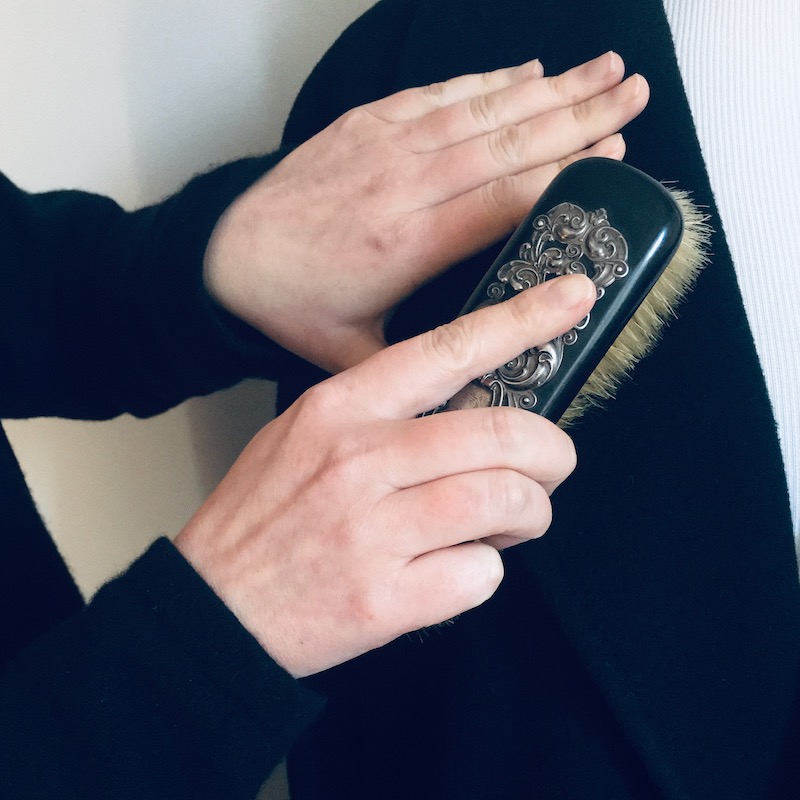
By the end of this year, Americans will have discarded an average of 81 pounds of clothing per person, the equivalent of 5 full wash loads of laundry in our modern home machines. Some of the main culprits: shrinkage, discoloration, and damage. In celebration of Earth Month, Southeastern New England Fibershed joins textile sustainability pioneer Reed McLaren of The Sustainable Garment as she seeks to uncover garment grooming, a lost art from a time when we may not have owned enough to fill even one wash load. Taking cues from the past and looking towards the future, she will guide us on how to care for some of her favorite textiles and garments in 3 installments: The Overcoat and the Brush, Cashmere and Fine Woolens, and Modern Athleisure.
The Lost Art of Garment Grooming Series Part 1 : The Overcoat and the Brush
We didn’t always wash all of our clothing.
That doesn’t mean they weren’t kept clean.
When laundry day comes, most of us simply throw our clothes into the washer and dryer without really considering the individual needs of a garment. When they end up looking worse for wear, we wonder what happened. And for those items that can’t be cleaned by the wash and dry method, we may pay them little attention at all.
Not so long ago, people held their clothes to a much higher standard of cleanliness than we afford the items hanging in our own closet. Washing was a laborious process that was reserved for our undergarments, the items that lived closest to our skin. But for all of our outer garments, from coats and jackets to dresses and trousers, the practice of grooming was an essential part of keeping these items in service in a time when our clothing ranked among the most valuable of our possessions.
While I have discovered various relics in antique and junk shops along the way, one item stands out as the fundamental tool for preservation: the garment brush. Fitted with natural hair such as boar or horse, brushes range from elaborate monogrammed sterling silver to a simpler wood, such as the ones still being produced today by long-standing companies like Redecker & Kent.

“Brushing is the first step in clothes care. All clothes look better for brushing, which restores their newness and freshens them up. And it removes dust, which is extremely important because dust is abrasive and in time will wear on your cloth.”
— Stanley Ager, 35 Years Head Butler at St. Michael’s Mount
In his book, The Butler’s Guide to Running the Home and Other Graces, Ager instructs on how to correctly use the tool: apply quick, short upward strokes against the nap of the garment to remove dirt followed by long, smooth downward strokes to restore the nap and lay the fibers down. During his time, Ager would have demonstrated this technique to the many valets in employ, a respected position that consisted of brushing the various outfit changes of the gentry and often came with his very own dedicated tools and workstation.
As Ager eludes, brushing was done for much more than the sake of appearance. It was a critical practice that helped maintain the health of the garment. If allowed to settle into the fiber, the dust, debris and oils from our skin and outside environment can weaken the garment over time, rendering it threadbare and unable to insulate and protect us from the elements. And brushing not only removes this potential damage, but also pulls out oils inherent in natural fibers to help condition and protect the garment.
When I apply this technique to my own clothing or demonstrate for others, people are astonished at how impeccable and well loved they look, and marvel that the beautiful tool in my hand dutifully performing this task is well over 100 years old. Many confide that the most attention their winter coats, jackets or blazers may get is a quick swipe with a sticky roller and perhaps a trip to the dry cleaners at the end of the season. A misnomer, many do not realize that the “dry” in dry cleaning refers only to the absence of water and are surprised to learn that it includes potentially damaging harsh liquid solvents and high-heat tumble drying. Luckily, the practice of brushing, combined with airing out and steaming to deodorize and the occasional spot clean, is all that is really needed to help our favorite coats look good and keep us comfortable for another year.
Join me in my next article as I cover how to care for my favorite fiber family: Cashmere and Fine Woolens.
Reed McLaren is available for consultations, workshops, presentations, and collaborations of all kinds via contact at reedmclaren@thesustainablegarment.com. Learn more about Reed by visiting The Sustainable Garment or follow her on instagram @thesustainablegarment.
